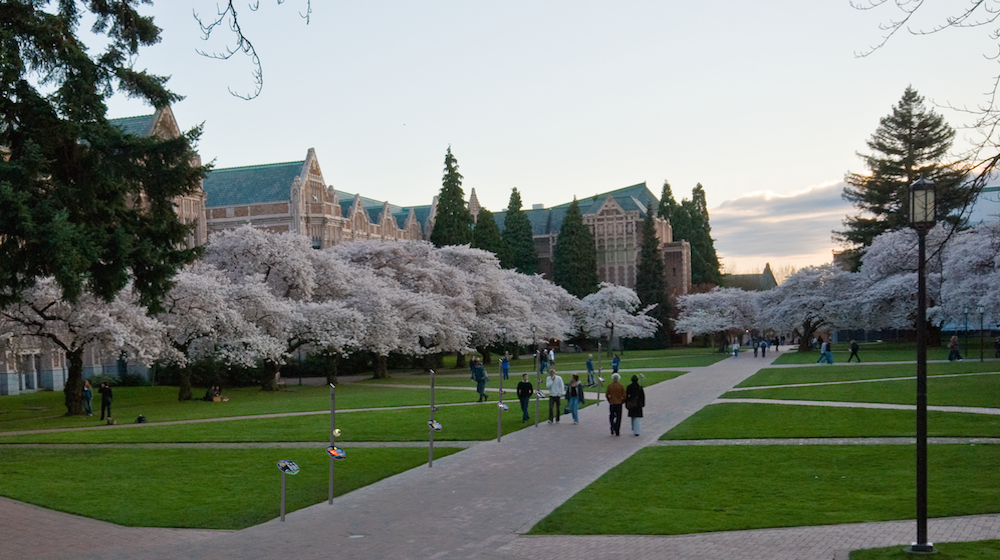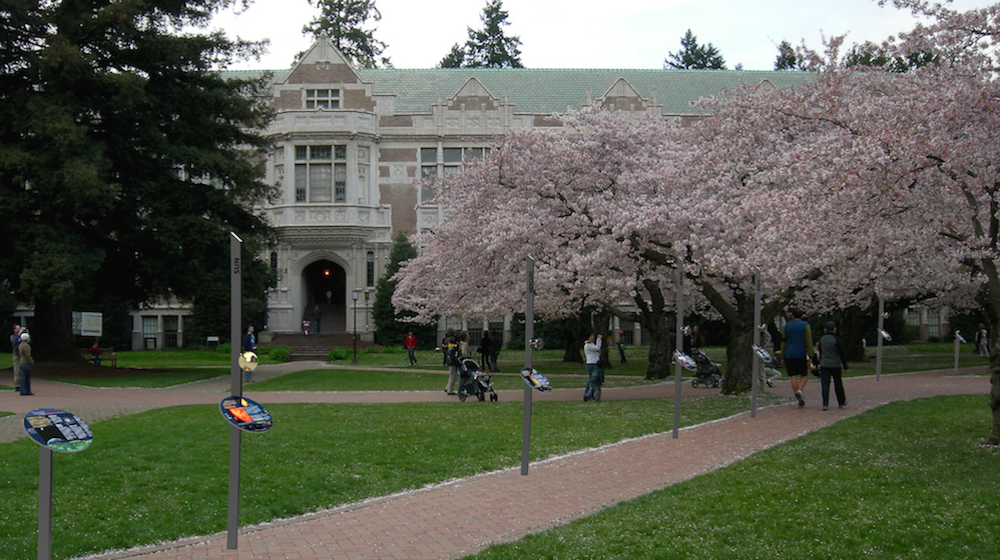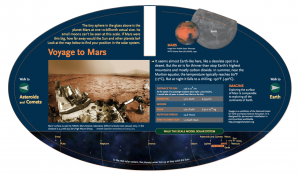NOTE: This is a sub-page of the Available Exhibitions page, which you should read first.
Last revised: May 24, 2024
Voyage Mark II Exhibition – Available 2021
The Voyage Mark II exhibition is a low cost highly accurate 1 to 10-billion scale model of the Solar System for permanent outdoor installation in communities across the Unites States and Canada. The exhibition leverages the extensive heritage of the Voyage Mark I scale model Solar System permanently installed on the National Mall in Washington, DC, between the U.S. Capitol and Washington Monument, and permanently installed in Houston, TX, Corpus Christi, TX, and Kansas City, MO.
1. Key Objectives
- provide exhibition visitors a conceptual understanding of Earth’s place in space, and the nature of worlds across our Solar System, through use of high precision models, text, imagery, and activities promoting inquiry-based exploration
- extend and enhance existing informal science and STEM education experiences to outdoor spaces
- foster a community engagement model for STEM education, with the means to engage: students in grades K-16; educators across grades K-12; families; and the general public
- foster experiences and programming that are strategic, addressing a community’s educational goals in STEM education; systemic, addressing the curriculum across local school districts; and sustainable, providing content and resources on an ongoing basis
- create a network of Voyage Communities, and foster inter-community exchange of ideas for educational programming
2. Appropriate Sites
Voyage is well suited for extended outdoor spaces, parks, college campuses, and downtown walkways. See artists concepts of the Voyage Mark II installed at various sites in the slider above.
Voyage –
- offers an added experience for family and general public visitors to a park or an extended outdoor space near, e.g., a museum or science center, and provides a greater context for an understanding of the natural world, planet Earth, and the sky above
- establishes a college or university as a local STEM education destination site
- provides an experiential thread along a downtown sidewalk, with opportunities for local businesses to leverage the experience with co-branded products and services
3. Voyage Mark II Exhibition Specifications, and Supplemental Educational Elements
Differences between the Mark I and Mark II exhibitions are addressed in the purple text below.
- a highly accurate model of the Solar System at one ten-billionth actual size, comprised of 13 stanchions spanning a reasonably linear 2,000 ft (600 meter) walking path; note that Voyage is only available at the 1 to 10-billion scale due to the embraced pedagogy for the visitorship experience – this scale cannot be modified to suit a specific site.
- the diameters of the Sun, planets, and moons, and the distances between them, are all represented on the same 1 to 10-billion scale. Read about Voyage’s accuracy.
- 13 anodized aluminum stanchions for: the Sun; 8 planets; Pluto; Comets/Asteroids; and two Entry stanchions on opposite sides of the exhibition (one near the Sun, and one near Pluto)
- a gold anodized model Sun with surface texture
- 8 planets, the dwarf planet Pluto, and 11 moons laser-sculpted in 3 dimensions inside solid crystal block with the following highlights:
– true oblateness for Jupiter and Saturn
– accurate ring systems and spin axial tilt for Jupiter, Saturn, Uranus, and Neptune
– visible cloud features on Jupiter, Saturn, and Neptune
– 11 moons at the correct scaled distance and orbital location relative to their parent planet: Earth’s Moon; Jupiter’s Io and Europa; Saturn’s Tethys, Dione, and Rhea; Uranus’ Ariel, Umbriel, and Titania; Neptune’s Triton; and Pluto’s Charon.
Note: the Mark I exhibition contains an additional 4 moons due to the larger crystal (Jupiter’s Ganymede and Callisto; Saturn’s Titan; and Uranus’ Oberon). - full color, high resolution storyboards using digital high pressure laminate (DHPL) panels for outdoor use (see https://fossilgraphics.com, and http://izoneimaging.com) that provide imagery and compelling content, and include a Site Map providing visitor location within the model Solar System. Text and imagery are designed to provide the visitor a conceptual understanding by building bridges to the familiar (click on the Mars storyboard image above).
Note: the Mark II exhibition storyboards can be upgraded to porcelain enamel, which is the material used in the Mark I exhibition – see Available Exhibition Upgrades below.
Note: the baseline Mark II exhibition storyboards include a generic site-independent Site Map (click on the storyboard image above). The baseline Mark II storyboards do not include the average number of steps to adjacent stanchions, or acknowledgment of local partners as is the case with the Mark I. The Mark II storyboards can be upgraded with a Customization Package, which includes a Site Map with local landmarks (see the Custom Site Map for Corpus Christi, TX), the average number of steps to adjacent stanchions if the path from the Sun to Pluto is reasonably linear (see the Mark I Jupiter Storyboard), and acknowledgment of local partners on the two Entry stanchions. See Available Exhibition Upgrades below. - for the blind and vision impaired, a set of tactile elements located on a plate mounted to the
front of each storyboard for the Sun, 8 planets, and Pluto; low placement of the plate provides easy access for children and visitors in wheelchairs. A visitor traveling through the solar system can feel the size of the Sun, planets, and Pluto at the 1 to 10-billion scale; tactilely read the name associated with each stanchion, which is provided in 5/8-inch tall raised block lettering; and scan a stanchion-specific QR (Quick Response) Code with a smart phone, which will auto-play an audio file of a narrator reading the storyboard. Click on the image at right.
- the names of the Sun, 8 planets, and dwarf planet Pluto at the top of their respective stanchions in vinyl lettering
Note: a Mark II upgrade package is available with names engraved at the top of the stanchions, as is the case for the Mark I exhibition. See Available Upgrades below. - a color master print file for a tour brochure – the Outdoor Exploration Guide (OEG) – promoting self-guided, inquiry-based exploration of the Solar System.
- a grade K-12 curriculum package, with lessons supporting pre-and post-visit activities, and relevant to curricular strands addressing Solar System content and exploration
- potential for supplemental programming, including: professional development for teachers, family and public programs, and researcher visits to classrooms across a community. Note: this is an additional cost borne by the community and covered in Section 4 below.
4. Costs
- baseline cost for Mark II exhibition: $49,500 (see Fundraising Assistance below), which includes exhibition fabrication; step-by-step procedures that address, e.g., identifying a viable site for the exhibition in your community, how to determine precise stanchion locations, and installation instructions; ongoing support from initial interest through installation; access to the grade K-12 curriculum package of lessons; and a color master for the Outdoor Exploration Guide (not customized to site)
- shipping: shipping to the community is a separate cost borne by the community, which includes the cost of crating and transportation; inquire for a cost estimate for your community
- installation: exhibition stanchions are embedded in poured concrete footings (or bolted to poured concrete footings – see Section 6.c below); installation is a separate cost borne by the community; inquire about the installation process, and how installation costs can be minimized
Note: a Mark II upgrade package is available for on-grade installation in softscape with stanchion mounting plates secured with bolts, as is the case for the Mark I exhibition. See Available Exhibition Upgrades below. - insurance: if the community feels insurance coverage of the exhibition is warranted, it is a separate cost borne by the community
- supplemental programming: supplemental programming is available through Journey through the Universe, another initiative of the National Center for Earth and Space Science Education, but is an added cost to the community. Journey through the Universe can provide some combination of: i) public and family programs as an exhibition opening event; ii) a national team of Earth and space science researchers visiting the community for a few days, and visiting potentially thousands of students one classrooms at a time; and iii) professional development for teachers on the Voyage grade K-12 curriculum package
5. Fundraising Assistance
The National Center for Earth and Space Science Education may be able to provide significant fundraising assistance, on a case-by-case basis, for communities working to secure the $49,500 baseline cost.
6. Available Exhibition Upgrades
- Upgrade Package A – Customization ($6,500): a customization package with the following upgrades: i) a Custom Site Map on each stanchion storyboard that includes local landmarks and way-finding information; and ii) acknowledgment of local partners on the two Entry stanchions.
- Upgrade Package B – Name Engraving ($3,950): instead of vinyl lettering, the engraved names with black backfill at the top of the 10 tall stanchions for: the Sun, 8 planets, and the dwarf planet Pluto
- Upgrade Package C – Bolt Down Mounting Plates ($7,500): installation of the baseline Mark II exhibition requires installation in ‘softscape’, i.e., where holes can be dug in the ground. A sonotube is placed in the hole, the below grade portion of each stanchion is placed in the sonotube, and concrete is poured. This Bolt Down upgrade provides stanchions fitted with mounting plates for bolting to concrete pads at grade. This is the only option in ‘hardscape’ such as a concrete plaza. In softscape, this also allows for easy removal and repositioning of a stanchion. in softscape, plate and bolt tops can hidden with mulch. In hardscape each bolt stud is covered with a cap nut for a finished appearance. See drawings for the two installation options: Installation Options (pdf)
- Upgrade Package D – Porcelain Enamel Storyboards ($19,950): instead of the Digital High Pressure Laminate (DHPL) storyboards for the baseline Mark II exhibition, storyboards are made of porcelain enamel, which is the material used for the Mark I exhibition.
7. Requirements
- Site: reasonably linear 2,000 ft (600 meter) walking path
- Implementation Plan: submission of an Implementation Plan by a community’s lead institution demonstrating how the exhibition and educational materials would be put to work to address the Key Objectives listed in Section 1 above
- Site Availability: a Letter of Site Authorization is required, which is signed by the institution with both legal authority over the site, and authority to approve permanent installation of the exhibition on the site
8. Mark II Production
Voyage Mark II exhibition production cannot begin until at least 5 communities are under contract, which is a key element to keeping the exhibition cost low. Each production run is to be designated a Mark II Generation. We envision multiple Mark II Generations to support interest in the United States alone.
Requesting a Mark II Exhibition Outside of a Production Run: we expect that there may be a situation where a community would like a Mark II exhibition rapidly, and cannot wait for potentially four other communities to come aboard for us to launch a production run. While we have the capacity to produce a ‘one-off’ exhibition by interrupting the production queue at Exhibitology, it requires set up then breakdown of significant tooling for just a single Mark II, and the subcontractors for fabrication of storyboards, crystal, anodize, and tactile plates will not provide any cost reduction for a single exhibition. The baseline cost for a one-off is $69,500 – which provides a sense of the significant cost reduction afforded by production economies of scale.
9. Generation 1 Announcement of Opportunity – January 2021
The Announcement of Opportunity for the first production run for the Voyage Mark II – designated Generation 1 – is to be announced in January 2021. If the first 5 communities come aboard quickly, we expect shipping to communities in Summer 2021.
10. How to Explore A Voyage Mark II Exhibition for Your Community
For more information on the Voyage Mark II design, community requirements, installation, cost, and how to apply to become a Voyage Community, contact Dr. Jeff Goldstein, Voyage National Program Director, and Center Director, National Center for Earth and Space Science Education, 301-395-0770, jeffgoldstein@ncesse.org





